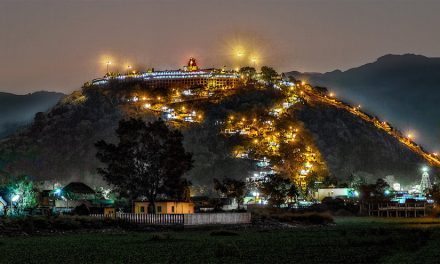The third stop on our Char Dham pilgrimage is the holy site of Kedarnath, which marks one of the twelve Jyotirlingas of Lord Siva. Framed by magnificent Himalayan peaks on the Kedarnath range, the ancient temple of Kedarnath sits 11,700 feet above sea level. This region of the Himalayas is also known as Gandhamadana parvatham and Sumera parvatham.
The term Kedara denotes Lord Siva in his aspect as the one who holds the holy Ganges in his matted locks and allows it to flow evenly to the world. It also refers to the mark left on Lord Shiva’s head from the time when Arjuna got the Paasupathastram.
Situated at the head of the Mandakini River, Kedarnath is considered one of the holiest places of pilgrimage in all of India. As described in sastra, when Lord Shiva wished to elude the Pandavas, he took refuge in Kedarnath, in the form of a bull. Finding a herd of cattle grazing in the marshy Kedar, he turned himself into a bull and mingled with the herd. The Pandavas were at a loss to find him, until Narada Muni suggested that Bhima stand with his feet on two adjoining mountains. The other four Pandavas could then round-up the cattle and drive them through Bhima’s legs.
Narada, of course, realized that all the cattle would pass under Bhima’s legs except the bull who was Shiva in disguise. Thus when the Pandavas found a solitary bull refusing to follow the herd, they ran after and corralled him. Shiva then began digging the soft earth so as to descend and escape. Bhima caught hold of the bull’s hump, and in exchange for their great perseverance, Shiva relented and give darshan to the Pandavas before disappearing underground.
After Shiva dived into the ground, he left behind his hump of the surface. Kedarnath (the hump) is therefore known as one of the Panch Kedar, being joined by sacred sites representing Shiva’s arms (bahu) at Tungnath, face (mukh) at Rudranath, navel (nabhi) at Madmaheshwar, and hair (jata) at Kalpeshwar. The hump is worshipped in the temple at Kedarnath in a conical Shiva pinda form, while the remaining parts of the body are worshipped at the other four locations.
While the Pandavas pursued Lord Shiva, the mountain path they traveled along is known as Sorga Vaasal. Sankaracharyara is understood to have also traveled along this route. The present temple at Kedarnath was built by Adi Guru Shankaracharya in the 8th century, and it is adjacent to the site where the Pandavas had once built a temple 5,000 years ago. To this day, Shankaracharya’s devotees serve as the temple functionaries, with a Nambudiripad Brahmin from Kerala as the chief priest/Rawal.
The ancient temple at Kedarnath has been renovated many times over the centuries. The current temple is a formidable structure, planted in the middle of a plateau with snow covered peaks of the Himalayas framing it. The temple architecture is exquisite, the outside being relatively unadorned with ornament, while the inside is richly embellished with lila scenes and figures. At the entrance to the sanctum sanctorum is a statue of Nandi, Lord Shiva’s vahana bull. The temple interiors are filled with many exquisite carvings. In the garba griha is the conically-shaped Jyotirlingam, believed to be the actual hump of the bull whose form Shiva assumed. Devotees pass through a small archway and up a short flight of stairs to reach the Deity, which they lovingly embrace in the mood of Bhima.
The sannadhi or main altar of Lord Shiva faces South. Deities of Lord Krishna, Kedaragowri, the Pancha Pandavas, Draupadi, Vinayagar, Veerabadrar, Kaarthikeyan, Parvati, Lakshmi, Narada, and Nandi are nearby. Outside, at the northeast corner is a small temple of Ishaneshwar Mahadev.
Just behind the temple, on the banks of the Mandakini, is found the samadhi of Adi Guru Shankaracharya, who took samadhi at the early age of 32, after establishing the four pilgrimages, or Char-dhamas. A small temple with his murti form and a Shivalinga are worshipped there. Between the samadhi and the main temple is a patch of bright greenery. The two temples are divided by a marble wall, and resting on the wall is a murti form of Shankara’s hand holding his danda.
Six months of the year the temple is covered in snow, and it is closed to pilgrims between Oct/Nov, opening again for Akshay Tritiya in April. During the period when no pilgrims visit, it is understood that the Devas are on site, worshipping the Deity.
There are several natural springs or kunds in the area. One, within the temple quadrangle, is known as Brahma Kund. At the front of the temple, along the main road, is the Udak Kund. To the right of the main temple is Hamsa Kund.












